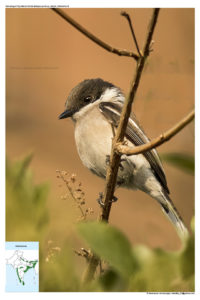Bar-winged Flycatcher Shrike

Bar-winged Flycatcher Shrike Hemipus picatus
Etymology :
- Hemipus : Greek word for hemi– half, small; pous- Foot
- Picatus : Latin word for “ Black and white, like smeared in Tar”
Vernacular Names : Hindi: Chhota kala latora, Sans: Kal-prushta shabal latushak, Lepcha: Viyum-pho, Guj: Kalopeeth kabaro latoro, Kabaro kashyo, Mar: Kabra khatik, Kavdya Mashimar Khatik, Mal: Asurappottan, Sinh: Panu-kurulla
Distribution in India: Resident of Himalayas, Hills of Western ghat , Hills of East and North East region in India
Description: Size of 14-15 cm. Male has top of head, upperparts and wings black, glossed green, lores to ear-coverts also black, cheeks and side of neck white; rump white, upper rump barred black, upper tail-coverts black; tail black, outermost feather narrowly edged white; throat and underparts white, greyer from lower throat and breast to anterior flanks; underwing-coverts mottled grey and white; iris dark brown; bill and legs black. Female is like male, but with black areas replaced by sooty brownish.
Habitat: It is found in Canopy of forest, including freshwater swamp-forest, tall secondary growth and forest edge; also mangroves, mature plantations and wooded gardens
Food Habits: It eats small insects. Commonly joins canopy-level mixed-species foraging parties. Snatches insects from underside of terminal foliage while hovering; also makes short flycatching flights, usually from an exposed perch
Breeding Habits: They breed in Malaysia in April-June. The nest is built by both sexes, a cup or a truncated cone with cup-shaped depression, made of lichens, bark fragments, fibers, bryophytes and spider webs, it is placed 7–40 m above ground on horizontal tree branch. They lay a clutch of 2-3 eggs. Chicks fed and brooded by both parents.
.